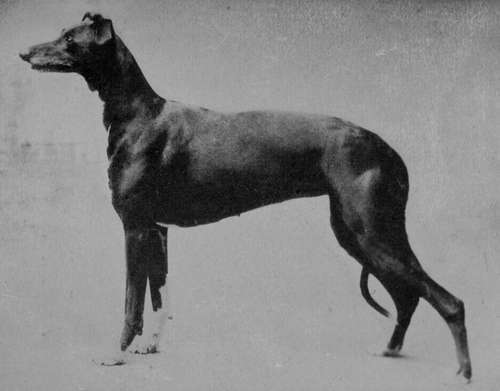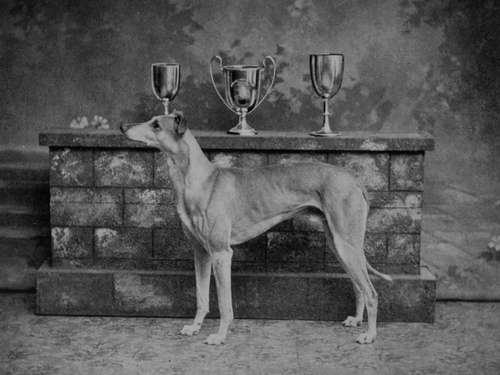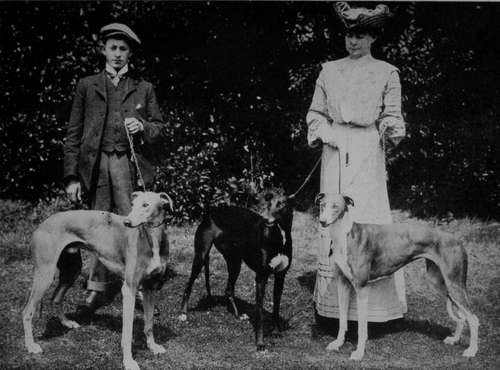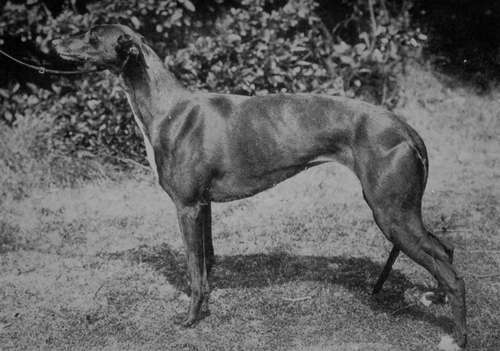The Greyhound
Description
This section is from the book "Sporting Dogs. Their Points And Management In Health, And Disease", by Frank Townend Barton. Also available from Amazon: Sporting Dogs; Their Points and Management in Health and Disease.
The Greyhound
From representations upon Egyptian monuments, etc., the Greyhound has been shown to have been in existence for three thousand years at least, and, according to Holinshead, was introduced into Britain some time during the third century. The first record of any coursing club in this country is said to be that founded by Lord Orford in Norfolk, during 1776.
The modern Greyhound is vastly superior to those of the ancients, if the old prints are faithful representations of these fleet-coursing thoroughbreds.
Although the Greyhound hunts by "sight," he is by no means " devoid " of hunting by " scent," as the Foxhound, Otterhound, etc. Misterton, winner of the Waterloo Cup in 1879 (63 lbs. weight); Coo-massie, winner of the Waterloo Cup twice (weight 42 lbs.); Master M'Grath, winner of the Waterloo Cup three times (54 lbs.), and Fullerton (65 lbs.), winner of the Waterloo Cup three times and a division of it the fourth time with his kennel companion, may be said to have been the grandest quartet of Greyhounds ever gracing the course.
To enter into a detailed account of the Greyhound would be quite outside the title and scope of this work, therefore the author will only give a brief outline of some of the more important points of these fleet-footed Hounds, which are as follows:—
Head
This should be long and narrow, wide between the ears and low between the eyes. The head of a bitch is of finer mould. Lean jaws.
Eyes
Penetrating and full of animation.
Ears
Elegantly carried and small.
Neck
Very important. Must be long, strong, very supple, and, above all, graceful. A high degree of flexibility is indispensable.
Fore Quarters
Shoulders must not be over-loaded with muscle, but a great degree of obliquity is a sine qua non.
Arm, long, ending below in a strong elbow joint.
Fore Arm
Very long, strong, and should consist of little beyond bone, muscles and tendons. It is in this region, particularly, that the Greyhound excels in beauty. Must be as straight as a line from elbow to knee, and, above all, well placed in relation to the parts above and below.
The forward position of the fore-limbs are a striking feature of the Greyhound, giving a minimum of weight to carry in front.
Long oblique pasterns, and compact hard feet are points of great importance.
Hind Quarters
Strength, width, and a great degree of flexibility are necessary in this region. Weak, or soft muscles destroys a Greyhound's speed, turning and staying power.

Greyhound Bitch Lady Golightly (Property of Mrs. DEWE).

Fawn Greyhound Dean Baden Powell (Property of Mr Eyers, Blandford).

A Trio of Greyhounds (Property of Mrs Dewe). Duke o' Ringmer. LAdy Golightly. Glory o' Ringmer.

Greyhound, Sussex Belle (Property of Mrs Dewe).
First and second thighs must be long, and well muscled.
The oblique position of the second thighs constitutes the main beauty in this region. Their backward curve joins the hocks in such a manner as to give the greatest possible leverage on the long, strong, pasterns and feet below.
The angles of the hocks are very acute, and, in relation to the body, placed very far back.
If a Greyhound has not typically formed and well-placed hind-quarters, he will never make his mark as a runner.
Chest
Most certainly should be deep, but not wide.
If a greyhound is not well-hearted he is no good for speed, or endurance.
Flatness of ribs, especially towards the keel, is advantageous.
Tail
Long and tapering.
Coat
Of medium texture, neither too coarse, nor too fine.
Colour
Unimportant. A good Greyhound may be any colour.
Our illustrations are from photographs kindly lent by Mrs Dewe of Ringmer, and Mr Eyers of Blandford.
Continue to:
- prev: Irish Wolfhounds
- Table of Contents
- next: The Whippet
